

Tami Gaylord
i am kind of shy. i am pretty much home based. i am very family and friend orientated . i love ice cream
Tarot. Divinities, Mythologies, Theologies. Symbols in books of alchemy. Sources: Wd1426, Wd1421A, Wv149, Ws2541A.

Books, Texts and Periodicals. Easy Sanskrit Online Course © Chinmaya International Foundation. Pagan Blog Project: G is for Gris-Gris. What is a Gris-Gris?

A Gris-Gris (aka grigri) is an African centric voodoo amulet which has a specific intent and purpose of protecting the wearer from evil spirits, negative forces, brings in luck and/or is used as a method of contraception*. It usually takes the shape of a small cloth bag and contains a ritualistic amount of small objects (usually a prime number between 3-13) and prayers from the Qur’an which is specifically tailored to the person who will be wearing it. Tina’s Make Your Own Gris-Gris Bag (© T. Georgitsis 2014) Ifá. Ifá refers to the system of divination and the verses of the literary corpus known as the Odù Ifá.

Yoruba religion and tradition identifies Orunmila as the Grand Priest, as he who revealed Oracle divinity to the world. Such is his association with the Oracle divinity; in some instances, the term "Ọ̀rúnmìlà" is used interchangeably with Ifá. Ifá originated in West Africa in the form of a stringent Yoruba religious system, and is celebrated in traditional African medicine, Santería (referred to as Lukumi), Candomblé, West African & Diaspora Vodou, and similarly in Orisa'Ifa lineages all over the globe. Yorùbá canon[edit] Togo canon[edit] The Vodun Phenomenon in Benin. If it can be said that homo faber preceded homo sapiens, both these stages of humanity were borne by homo religiosus, an essential feature of man since the arousal of his consciousness.
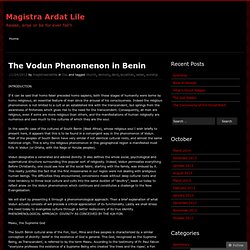
Indeed the religious phenomenon is not limited to a cult or an established link with the transcendent, but springs from the awareness of finiteness which gives rise to the need for the transcendent. Magistra Ardat Lile. Life History Marie Laveau (September 10, 1782 – June 16, 1881) was a Louisiana Creole practitioner of Voodoo renown in New Orleans.
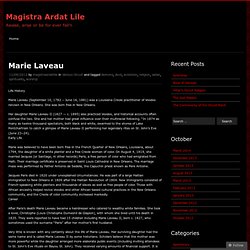
She was born free in New Orleans. Her daughter Marie Laveau II (1827 — c. 1895) also practiced Voodoo, and historical accounts often confuse the two. She and her mother had great influence over their multiracial following. “In 1874 as many as twelve thousand spectators, both black and white, swarmed to the shores of Lake Pontchartrain to catch a glimpse of Marie Laveau II performing her legendary rites on St. Magistra Ardat Lile. Voudoun Conceptualism or Understanding?
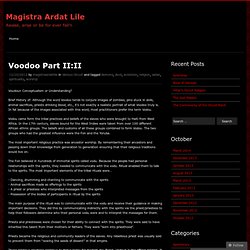
Brief History of: Although the word Voodoo tends to conjure images of zombies, pins stuck in dolls, animal sacrifices, priests drinking blood, etc., it’s not exactly a realistic portrait of what Voodoo truly is. In fat because of the images associated with this word, most practitioners prefer the term Vodou. Haiti: List of Loa. Raw Power and Dark Energies. The Sorcerer is characterized by an inherent need to explore the deepest, darkest parts of his or her self.
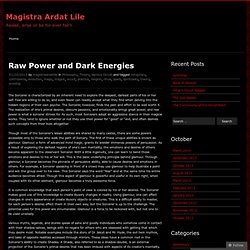
Few are willing to do so, and even fewer can readily accept what they find when delving into the hidden regions of their own psyche. The Sorcerer, however, finds the pain and effort to be well worth it. The realization of one’s primal desires, obscure passions, and emotionality brings great power, and raw power is what a sorcerer strives for. As such, most Sorcerers adopt an aggressive stance in their magical works. They tend to ignore whether or not they use their power for “good” or “evil, and often dismiss such concepts from their lives altogether. Magistra Ardat Lile.
Death magics have been around for as long as humans have grasped the concept of using magic of any form.

Even the most basic division of magics must include a segment for that which is known as Necromancy. Though Necromancy currently has a functional etymology to it, this was not always the case. In the medieval ages, “Necromancy” was called “Nigromancy”, meaning “Black Magic” (interpreted as that which harms the person). VODOU RITUALS & CEREMONIES. The Haitian Vodou Religions are full of different types of rituals and ceremonies that are conducted.
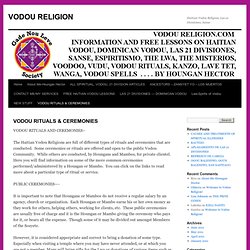
Some ceremonies or rituals are offered and open to the public Vodou Community. While others are conducted, by Houngans and Mambos, for private clientel. Here you will find information on some of the more common ceremonies performed/administered by a Houngan or Mambo. Haitian Vodou. Vodou altar during a celebration for Papa Guédé in Boston.
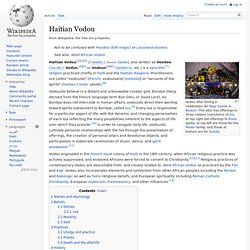
This altar has offerings to three nations (nanchons) of loa: at top right are offerings to Rada spirits; at top left are those for the Petwo family; and those at bottom are for Guédé. Haitian Vodou[3] (/ˈvoʊduː/, French: [vodu], also written as Voodoo /ˈvuːduː/; Vodun,[4] or Vodoun[4] /ˈvoʊduːn/, etc.) is a syncretic religion practiced chiefly in Haiti and the Haitian diaspora. Practitioners are called "vodouists" (French: vodouisants [voduisɑ̃]) or "servants of the spirits" (Haitian Creole: sèvitè). Vodouists believe in a distant and unknowable creator god, Bondye (likely derived from the French language term Bon Dieu, or Good Lord). VODOU RITUALS & CEREMONIES. Yoruba Theology. Vodou. Magic (paranormal) Magic or sorcery is an attempt to understand, experience and influence the world using rituals, symbols, actions, gestures and language.[1][2][3][4] Modern Western magicians generally state magic's primary purpose to be personal spiritual growth.[5] Modern theories of magic may see it as the result of a universal sympathy where some act can produce a result somewhere else, or as a collaboration with spirits who cause the effect.[6] The belief in and the practice of magic has been present since the earliest human cultures and continues to have an important religious and medicinal role in many cultures today.[7][8] Magic is often viewed with suspicion by the wider community, and is sometimes practiced in isolation and secrecy.[4] The word "magic" derives via Latin magicus from the Greek adjective magikos (μαγικός) used in reference to the "magical" arts of the Persian Magicians (Greek: magoi, singular mágos, μάγος), the Zoroastrian astrologer priests of the ancient Persian Empire.
Chaos magic. The chaosphere is a popular symbol of chaos magic. Many variants exist. For more, see Symbol of Chaos. General principles[edit] Chaos magicians are often seen by other occultists as dangerous or worrisome revolutionaries.[2] History[edit] Chaos magic.
Adept. An adept is an individual identified as having attained a specific level of knowledge, skill, or aptitude in doctrines relevant to a particular author or organization. Etymology[edit] Hermeticism. Not to be confused with Hermit. Hermeticism, also called Hermetism,[1][2] is a religious and philosophical/esoteric tradition based primarily upon writings attributed to Hermes Trismegistus ("Thrice Great").[3] These writings have greatly influenced the Western esoteric tradition and were considered to be of great importance during both the Renaissance[4] and the Reformation.[5] The tradition claims descent from a prisca theologia, a doctrine that affirms the existence of a single, true theology that is present in all religions and that was given by God to man in antiquity.[6][7] Many Christian writers, including Lactantius, Augustine,[8] Thomas Aquinas[citation needed], Marsilio Ficino, Giovanni Pico della Mirandola, Giordano Bruno, Campanella, Sir Thomas Browne, and Emerson, considered Hermes Trismegistus to be a wise pagan prophet who foresaw the coming of Christianity.[9][10]
European witchcraft. Belief in and practice of witchcraft in Europe can be traced to classical antiquity and has continuous history during the Middle Ages, culminating in the Early Modern witch hunts and giving rise to the fairy tale and popular culture "witch" stock character of modern times, as well as to the concept of the "modern witch" in Wicca and related movements of "contemporary witchcraft. History[edit] Antiquity[edit] Instances of persecution of witchcraft are documented from Classical Antiquity, paralleling evidence from the Ancient Near East and the Old Testament. Magick. Emerald Tablet of Hermes. Sacred-Texts Esoteric Index Previous Next. Gnostic Teachings. T h e E m e r a l d T a b l e t s. Alchemical archives. Gnosticism/Hermetica/Alchemy. Angels. Potion Recipes. Herbology.
Daemons. Occult. Witchcraft Links. Welcome to the Kitchen Witch Corner - Kitchen Witch Corner. Witchcraft and Magick. Internet Sacred Text Archive Home. Witch School International - Your Online Wicca and Magickal Education Source. Cyber cauldron school of eclectic witchcraft. Welcome to the Kitchen Witch Corner - Kitchen Witch Corner. Witchcraft Links.